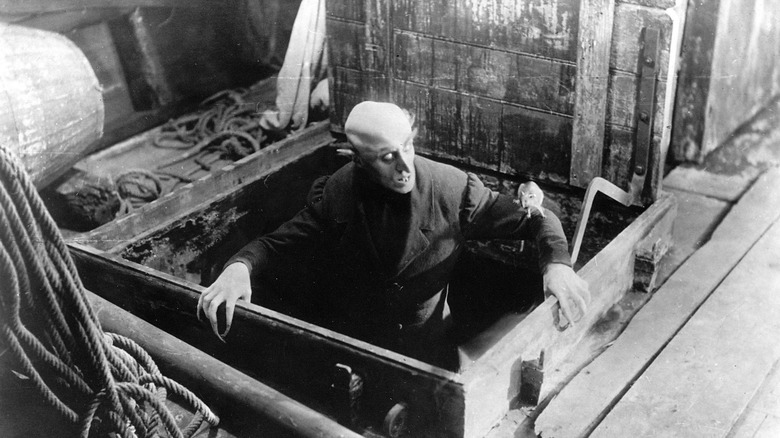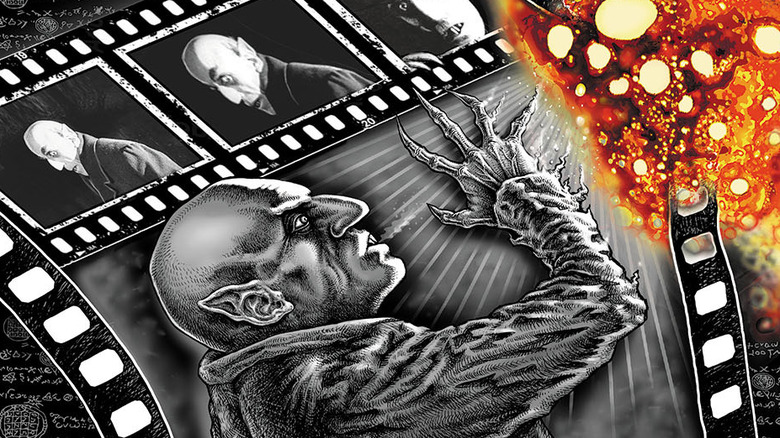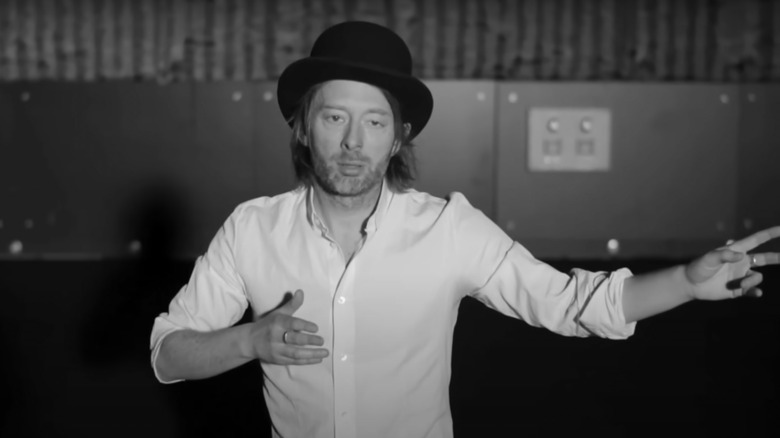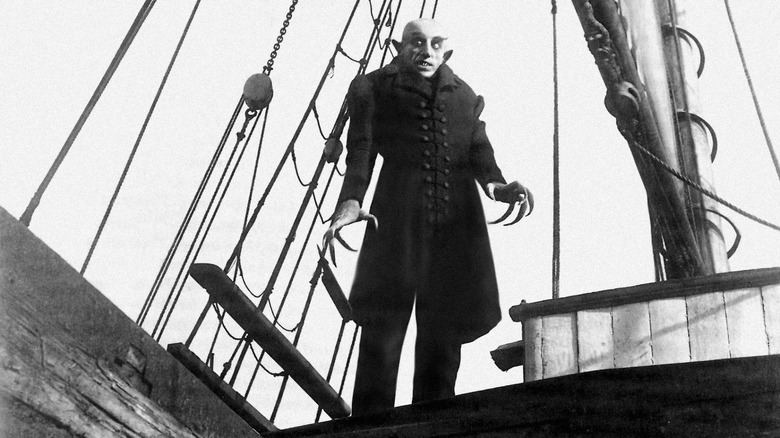How Radiohead Brings Eerie New Life To One Of The Greatest Horror Movies Ever
As the calendar turns over to October, so, too, does the programming of arthouse theaters turn to the spooky — and royalty-free — hallmarks of silent horror cinema. F. W. Murnau's "Nosferatu" is one popular choice for repertory screenings and live musical performances, and this year, the new Austin-based Silents Synced series is taking things a step further. Thanks to their hard work, "Nosferatu" will play in theaters all month long accompanied by a new soundtrack: Radiohead's seminal albums "Kid A" and "Amnesiac."
For some, the idea of mixing silent cinema with modern artists may feel like a YouTube video that has escaped its cage and run amok through the halls of film distribution. But having experienced the "Nosferatu" and Radiohead mashup for myself, I think there's more to the series than a cool poster. With this film and future releases — such as Buster Keaton's "Sherlock, Jr." mixed with R.E.M. — Silents Synced is honoring the populist musical roots of silent cinema while also making the emotions and craft of films like "Nosferatu" more accessible to a new generation of moviegoers.
Silent films and pop music go hand in hand
Unlike modern cinema, the soundtracks for silent cinema were a mishmash of prewritten orchestral music, curated musical cues, and live musical improvisation. Some films would be accompanied by booklets of recycled popular motifs; others would release with nothing, forcing house musicians who had never seen the movie to manufacture an entire soundtrack in real time. Those of us raised on home video may treat the accompanying soundtracks for films like "Nosferatu" as the standard, but over time, the tenuous relationship between silent cinema and music has led to many new interpretations by modern artists.
Because many movies of this period do not include a canonical score, silent films offer those interested in the intersection of cinema and cinematic experiences with opportunities to bridge these two worlds in unique ways. Scroll through your local community calendar and you will no doubt find a number of silent screenings in your market accompanied by string quartets or regional orchestrals. In some cases, silent film screenings will even be accompanied by brand new scores composed by local or national artists.
For example, the New York-based band Morricone Youth is known for their original re-releases of scores to films like "Battleship Potemkin" and "The Lodger" and have even dabbled in soundtracks for more modern releases like "Mad Max" and "Night of the Living Dead." While Morricone Youth takes the extra step of writing (and retailing) their film scores, the underlying concept is not that far off the historical standard: the music for silent films is ephemeral, and modern artists are welcome to tackle film scores as they see fit.
And while "Nosferatu" was originally complemented by a full orchestral score written by Hans Erdmann, that music has been lost to time. As such, modern repertory screenings of the film often favor original scores; rock collective The Invincible Czars toured the country for two months in 2022 to accompany screenings of "Nosferatu" for its centennial anniversary.
But both of these approaches to silent cinema — contemporary musical cues or modern compositions — still serve to make the movie itself the focus of the artistic experience. Does adding popular bands like Radiohead or R.E.M. to a silent movie improve the viewing experience? Or is it little more than a musical gimmick coasting on the coattails of Pink Floyd and the "The Wizard of Oz"?
Modern music provides a bridge to the past
Where you sit on this probably boils down to personal preference. But here's one thing I would like to leave you with: if music be the food of love, then adding songs known to modern audiences goes a long way towards opening up the emotional connection we can make with silent cinema. Radiohead makes "Nosferatu" more immediate thanks to our preexisting relationship to these songs.
To watch a silent film is to step into a past where aesthetic and performance decisions were rooted more in stagecraft than in cinema. That can sometimes be the knock movies like "Nosferatu" get with new audiences: for all its iconic moments, there is a theatricality to performance — broad emotions meant to convey narrative concepts between title cards — that highlight the artifice and keep immersion at a distance. Adding more traditional musical cues to the screening only exacerbates that disconnect, making some viewers even more aware that they are observing a historical artifact instead of living, breathing cinema.
But when you combine "Nosferatu" with the sonic landscapes of a band like Radiohead, you provide audiences with an emotional shorthand that grants them easier access to the underlying emotions and ideas of Murnau's film. Radiohead's songs often echo the tone poems of classical music; they are short emotional gestures that are strung together to form a collection of cohesive musical ideas. Watching Count Orlok cast his spell over Thomas Hutter feels conceptually aligned with the off-kilter instrumentation of "Amnesiac," but the angst conveyed in Thom Yorke's voice adds a sense of urgency to Hutter's unraveling. It's a good match.
That's part of the magic of watching silent movies merge the familiar and the unfamiliar. I'd seen "Nosferatu" in theaters before, but when combined with music meant to evoke modern emotions, I found myself connecting with the film more than I had in the past. No longer was I sitting outside a piece of art looking in — Radiohead's music sparked real feeling in me, creating a sense of immediacy about both performers and aesthetic that had been missing in previous viewings. And that let me lose myself more than ever before in the performances and production design that makes "Nosferatu" such a marvel to this day.
Silent cinema is as relevant as ever
Whether it's live or prerecorded, there is something magical about watching silent cinema interpreted by modern artists. The ephemeral nature of movie music — and the fact that many of these films were always meant to be accompanied by the contemporary standards of popular music — allows us to play with the form without compromising the artistic ideas of the original filmmakers. And while the studios of the 1920s probably could not have conceived of a song like "Everything In Its Right Place" when they sent out cue books to local theaters, it is not such a leap of logic or aesthetic to pair Yorke and Orlok on the big screen.
But as Silents Synced brings its "Nosferatu" screenings to arthouse theaters across the country, what I hope is that this mashup of the known and the unknown will open doors to a new generation of silent cinema fans. Robert Eggers's adaptation of "Nosferatu" will be in theaters soon, and those who want to experience Murnau's classic before the new adaptation will no doubt find the Radiohead version a more immersive experience. And anything that invites more audiences into the full breadth of film history is a welcome cinematic invention in my book.



